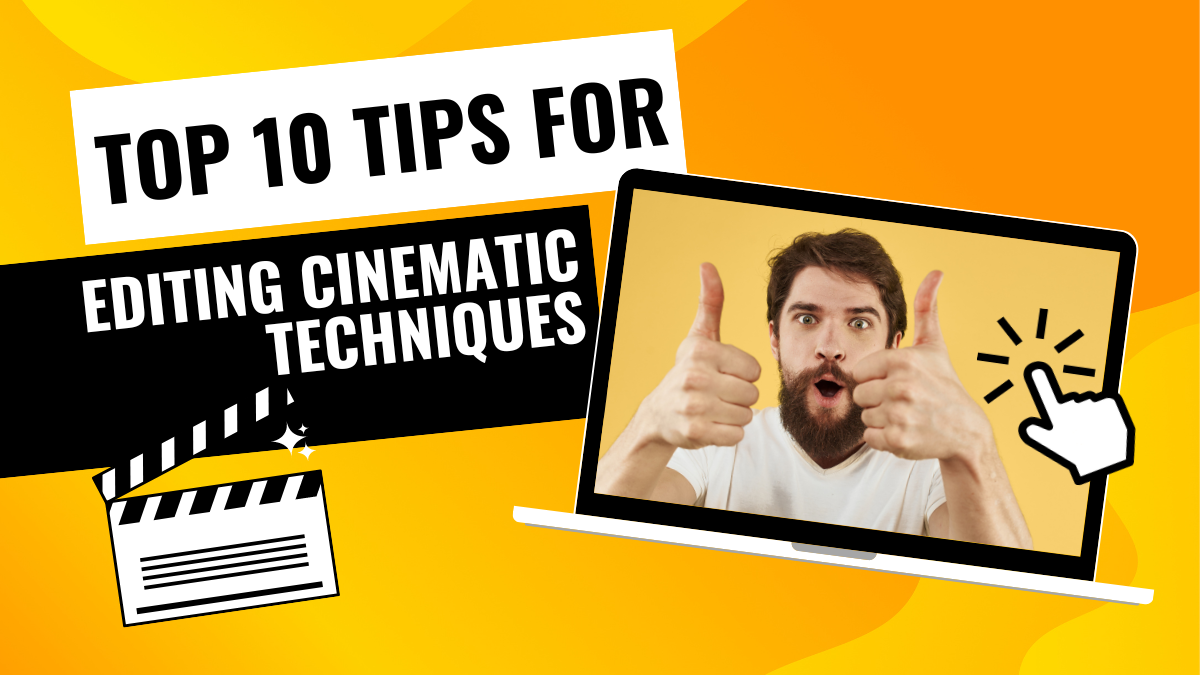
Editing Cinematic Techniques In the realm of filmmaking, editing is the secret ingredient that transforms raw footage into a cohesive, captivating narrative. Cinematic techniques in editing play a crucial role in shaping the story, evoking emotions, and engaging audiences. From basic cutting to advanced visual effects, editors employ a variety of techniques to bring stories to life on the screen. In this article, we delve into the world of editing cinematic techniques, exploring their intricacies, applications, and impact on the storytelling process.
Table of Contents
Introduction to Editing Cinematic Techniques
Editing is often described as the “invisible art” of filmmaking. It involves the selection, arrangement, and manipulation of footage to create a seamless flow of images and sounds. Cinematic techniques refer to the specific methods and approaches used by editors to achieve desired effects in a film. Whether it’s creating suspense through pacing or conveying emotion through montage, editing techniques are fundamental to the art of storytelling in cinema.
1. Basic Editing Techniques
Cutting
Cutting, also known as editing or splicing, is the fundamental building block of film editing. It involves removing unwanted footage and joining together different shots to create a cohesive sequence. By controlling the duration and rhythm of shots, editors can influence the pace and mood of a scene.
Continuity Editing
Continuity editing aims to maintain a sense of spatial and temporal coherence within a scene or sequence. It relies on techniques such as matching action, eyeline matches, and the 180-degree rule to ensure smooth transitions between shots.
Montage
Montage is a technique where a series of short shots are edited together to condense time, space, and information. It can be used to compress narrative events, convey emotions, or illustrate thematic connections between disparate elements.
Transitions
Transitions are used to link one shot to the next, providing visual continuity between scenes. Common types of transitions include cuts, fades, dissolves, wipes, and iris effects.
2. Advanced Editing Techniques
Parallel Editing
Parallel editing, also known as cross-cutting or intercutting, involves cutting between two or more separate actions or locations that are happening simultaneously. It can create tension, build suspense, or highlight thematic parallels between different storylines.
Cross-Cutting
Cross-cutting is similar to parallel editing but typically involves cutting between two or more related actions or locations that are happening sequentially. It can be used to establish spatial or temporal relationships between different narrative strands.
Match Cuts
Match cuts are edits where elements in successive shots match each other in some way, such as composition, movement, or subject matter. They can create seamless transitions between scenes or highlight thematic connections between disparate images.
Jump Cuts
Jump cuts are abrupt transitions between shots of the same subject, resulting in a discontinuous and disorienting effect. They are often used for stylistic purposes or to convey a sense of temporal distortion or psychological unease.
3. Narrative Techniques in Editing Cinematic Techniques
Flashbacks
Flashbacks are scenes that depict events that occurred in the past. They can provide backstory, deepen characterization, or reveal crucial information about the plot.
Flash-forwards
Flash-forwards are scenes that depict events that will occur in the future. They can create anticipation, foreshadow future developments, or provide dramatic irony for the audience.
Non-linear Storytelling
Non-linear storytelling involves presenting events out of chronological order. It can add complexity to the narrative structure, challenge audience expectations, and invite multiple interpretations of the story.
4. Aesthetic Techniques
Slow Motion
Slow motion is a technique where action is filmed at a higher frame rate than usual and then played back at normal speed. It can emphasize moments of drama, beauty, or intensity, allowing viewers to savor every detail.
Time-lapse
Time-lapse is a technique where long periods of time are compressed into a short sequence, creating a sense of accelerated motion. It can be used to show natural processes, urban development, or the passage of time in a visually striking way.
Freeze Frame
Freeze frame is a technique where a single frame of footage is repeated or prolonged to create a static image. It can be used to emphasize a dramatic moment, highlight a character’s reaction, or punctuate a scene with visual impact.
Split Screen
Split screen is a technique where multiple images are displayed simultaneously on the screen, usually divided into separate panels. It can be used to show parallel actions, juxtapose different perspectives, or convey interconnectedness between characters or events.
5. Sound Editing Techniques
Sound Effects
Sound effects are audio recordings that simulate real or imaginary sounds, such as footsteps, explosions, or animal noises. They can enhance the realism of a scene, create atmosphere, or evoke emotional responses from the audience.
Foley
Foley is the art of creating and recording sound effects in a studio environment, typically performed by Foley artists using props and materials to mimic real-world sounds. It can add depth and texture to the audio track, making the soundscape more immersive and engaging.
Music Editing
Music editing involves selecting, arranging, and synchronizing music tracks with the visual elements of a film. It can set the mood, evoke emotions, or underscore dramatic moments, enhancing the overall impact of the storytelling experience.
6. Color Grading and Visual Effects in Editing Cinematic Techniques
Color Correction
Color correction is the process of adjusting and enhancing the color and contrast of footage to achieve a desired look or mood. It can be used to correct technical imperfections, create stylistic effects, or establish visual consistency throughout a film.
CGI
Computer-generated imagery (CGI) involves creating and integrating digital elements into live-action footage. It can be used to depict fantastical creatures, epic landscapes, or elaborate special effects that would be impractical or impossible to achieve using practical methods.
Green Screen
Green screen, also known as chroma keying, is a technique where actors are filmed against a solid-colored background, which is later replaced with a different background during post-production. It allows filmmakers to place characters in virtual environments, interact with CGI elements, or composite multiple layers of imagery.
7. Experimental Editing Techniques
Experimental Narrative Structures
Experimental narrative structures involve unconventional approaches to storytelling, such as fragmented narratives, stream-of-consciousness editing, or nonlinear plotlines. They can challenge traditional storytelling conventions, provoke thought, or stimulate the imagination.
Found Footage
Found footage is a filmmaking technique where the narrative is presented as if it were discovered or recovered footage, often purported to be real or documentary in nature. It can create a sense of authenticity, immediacy, or voyeurism, blurring the line between fiction and reality.
Collage
Collage is a visual art technique where different images or materials are combined and arranged to create a new composition. In filmmaking, collage editing involves juxtaposing disparate elements, such as archival footage, photographs, or animation, to create a collage-like effect.
8. Impact of Editing on Storytelling in Editing Cinematic Techniques
Editing plays a pivotal role in shaping the narrative structure, pacing, and emotional impact of a film. By selecting the right shots, arranging them in a meaningful sequence, and adding sound and visual effects, editors can enhance the story’s coherence, rhythm, and resonance.
Challenges and Limitations
Despite its creative potential, editing also poses various challenges and limitations. Technical constraints, such as equipment limitations or compatibility issues, can hinder the editing process. Time constraints, tight deadlines, and budget limitations may also limit the scope of editing possibilities(Editing Cinematic Techniques).
9. Tools and Software
Editors rely on a variety of tools and software to bring their creative visions to life. Popular editing software includes Adobe Premiere Pro, Final Cut Pro, Avid Media Composer, and DaVinci Resolve, each offering unique features and capabilities to suit different editing workflows in Editing Cinematic Techniques.
Famous Examples of Editing Cinematic Techniques
Numerous films have pushed the boundaries of editing cinematic techniques, leaving a lasting impact on the medium. Iconic examples include Alfred Hitchcock’s “Psycho,” renowned for its innovative editing techniques and suspenseful pacing; Quentin Tarantino’s “Pulp Fiction,” celebrated for its nonlinear narrative structure and witty dialogue; and Christopher Nolan’s “Inception,” lauded for its mind-bending visuals and intricate temporal manipulation.
10. Future Trends in Editing
As technology continues to evolve, the future of editing promises to be filled with exciting possibilities. Virtual reality editing, augmented reality overlays, and immersive storytelling experiences are just a few examples of emerging trends that could revolutionize the way films are edited and experienced by audiences.
Ethical Considerations in Editing Cinematic Techniques
While editing offers boundless creative potential, it also raises important ethical considerations. Manipulation of reality through editing techniques can distort perceptions, perpetuate stereotypes, or misrepresent historical events. Filmmakers must navigate these ethical dilemmas with sensitivity and integrity, striving to balance artistic expression with social responsibility.
Visit Website :- guest post buy
Also Visit :- Telegram
Conclusion
In conclusion, editing cinematic techniques are a vital component of the filmmaking process, shaping narratives, eliciting emotions, and captivating audiences. From basic cutting to advanced visual effects, editors wield a powerful toolset to craft compelling stories that resonate with viewers. As technology advances and storytelling evolves, the future of editing holds endless possibilities for innovation and creativity.
FAQs (Frequently Asked Questions)
What is the role of editing in filmmaking?
Ans. Editing plays a crucial role in shaping the narrative structure, pacing, and emotional impact of a film. It allows filmmakers to craft compelling stories, evoke emotions, and engage audiences.
What are some famous examples of innovative editing techniques?
Ans. Iconic examples include Alfred Hitchcock’s “Psycho,” known for its suspenseful editing; Quentin Tarantino’s “Pulp Fiction,” celebrated for its nonlinear narrative; and Christopher Nolan’s “Inception,” lauded for its mind-bending visuals.
What software do editors use for editing cinematic techniques?
Ans. Popular editing software includes Adobe Premiere Pro, Final Cut Pro, Avid Media Composer, and DaVinci Resolve, each offering unique features and capabilities for editing workflows.
How do editing techniques impact storytelling?
Ans. Editing techniques influence the narrative structure, pacing, and emotional resonance of a film. By selecting the right shots, arranging them in a meaningful sequence, and adding sound and visual effects, editors can enhance the story’s coherence and impact.
What are some ethical considerations in film editing?
Ans. Filmmakers must navigate ethical dilemmas related to the manipulation of reality, representation of sensitive subjects, and adherence to cultural and historical accuracy. It’s essential to balance artistic expression with social responsibility.





